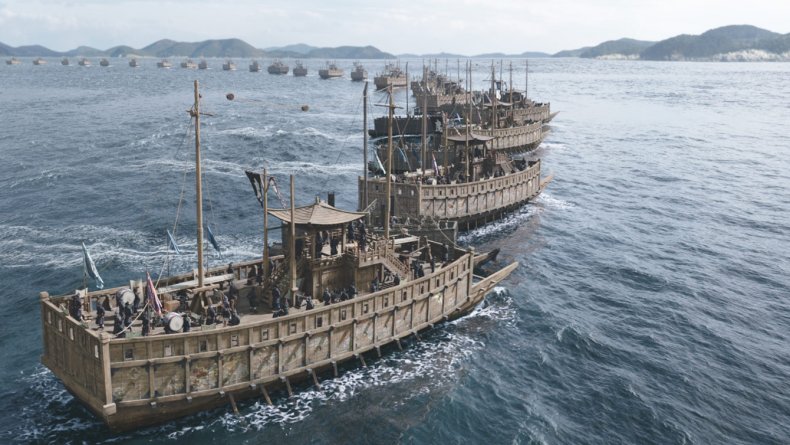


“Hansan: Rising Dragon” is a Korean naval war epic that takes us into the actions — before and during a series of sea battles in the 1590s — of Korea’s great naval genius, Admiral Yi Soon Shin.
It’s a sprawling and dense period piece with a fleet’s worth of characters moving from bases and fortresses, to land campaigns, shipyards, fractious war councils and battles on board armored galleys. Here, all that is boiled down to the bloody chess game and military innovations of competing admirals — the Japanese “Wae” invader Wakizaka (Byon Yo-han) and the “righteous” defender of Joseon (the Korean peninsula dynasty), Yi Soon Shin (Park Hae-il).
For a Westerner, think of it as being more “300: Rise of an Empire” than John Woo’s Chinese “Red Cliff” epic. It’s a CGI-assisted old-fashioned flag waver filled with chaotic combat in which the day is always saved by the sudden lifting of this fog, the shocking arrival of that surprise fleet or the out-of-nowhere cannon balls that forestall the certain doom ready to befall this or that brave, patriotic Korean.
The phrase “It’s a TRAP!” (in Korean, with English subtitles) erupts so often I half-expected “Star Wars” Admiral Ackbar to make his presence known. But he’s here in spirit.
Set during the most perilous phase of the Imjin War, we learn that the Wae — fresh from staging the largest seaborne invasion in history (to that point) are on the brink of total conquest of the Korean peninsula, with only cunning Admiral Yi Soon (sometimes spelled “Sun”) Shin and his fleet of galleys in the country’s southern region standing in their way.
The “secret weapons” of this conflict are the the Koreans‘ “turtle ships,” covered galleys called Geobukseon with bronze dragon head rams in their bows which terrorized the Japanese, whose smaller galleys — some of them armor plated, had enough to deal with in fighting the bigger, more heavily-built Panokseon galleys that were the main Korean combat vessels.
Much of the movie has this admiral strategizing with his subordinates to figure out the weaknesses of the other side. Covered “turtles” may have spikes on their backs to prevent boarding, but are blind to what they’re charging into. The Koreans didn’t try to rapidly reload their cannons. They used their superhuman rowers to spin the ship around to bring a fresh broadside of cannons to bear on the enemy after each volley. The Japanese schemed to exploit these weaknesses with their smaller, quicker, more lightly-armed and far more numerous galleys, which sought to board the enemy and win the fight with samurai wielding their katana swords.
There are spies and saboteurs, and the war councils threaten to dissolve into infighting blood feuds — especially among the hotheaded Japanese warlords.
All of which are just the preliminaries leading to an epic sea fight, an Asian version of the Greco-Persian Battle of Salamis with enemies in rowing galleys battling among the rocks and narrow passages of a strait littered with islets and islands.
Only those deep into naval history — or Korean history — will have heard much about these titanic struggles in the seas off Korea, or be all that interested in a movie about it. There’s a reason the West has never produced a proper epic about the Battle of Lepanto, Europe’s last great galley battle, which thwarted the Ottoman Turks from pouring into central Europe and Italy and happened over 20 years before the Battle of Hansan Island. This sort of overpopulated war picture is complex and expensive to put on the screen, makes for seriously cluttered storytelling and has limited appeal, being about mostly-forgotten pieces of history.
Leading up to its Big Action Finish, “Hansan: Rising Dragon” is an oft-unwieldy film, struggling to keep the many fields of conflict and layers of intrigue straight.
Technically, writer-director Kim Han-min shows off period-appropriate firearms, armor, tactics and hardware, and galleys scooting through the water like Jetskis. There was a lumbering, slow-motion nature to this two thousand year era in combat, with the ships too heavy to move without armies of enslaved (in the Middle East and West) rowers. The number of two-man oars dipping into the water here could never propel these vessels at those speeds, something “Hansan” ignores for the sake of fast action.
See “Ben-Hur” for examples of why that makes no sense. And remember, the Spanish Armada battles of just a few years before (1588) had already turned Europe away from labor-intensive rowed galley combat close to shore and to sailing galleons, caravels and later frigates and ships of the line fighting it out under sail.
But “Rising Dragon” still makes a fascinating film version of a “further reading” history lesson, a reminder of the historical enmity between Korean and its avaricious, warlike neighbor and why Koreans in the film and in the modern day regard this as a “battle of the righteous against the unrighteous.”
Rating: unrated, violence
Cast: Park Hae-il, Byon Yo-han
Credits: Written and directed by Kim Han-min, based on the graphic novel “Yi Soon Shin.” A Well Go USA release.
Running time: 2:09

